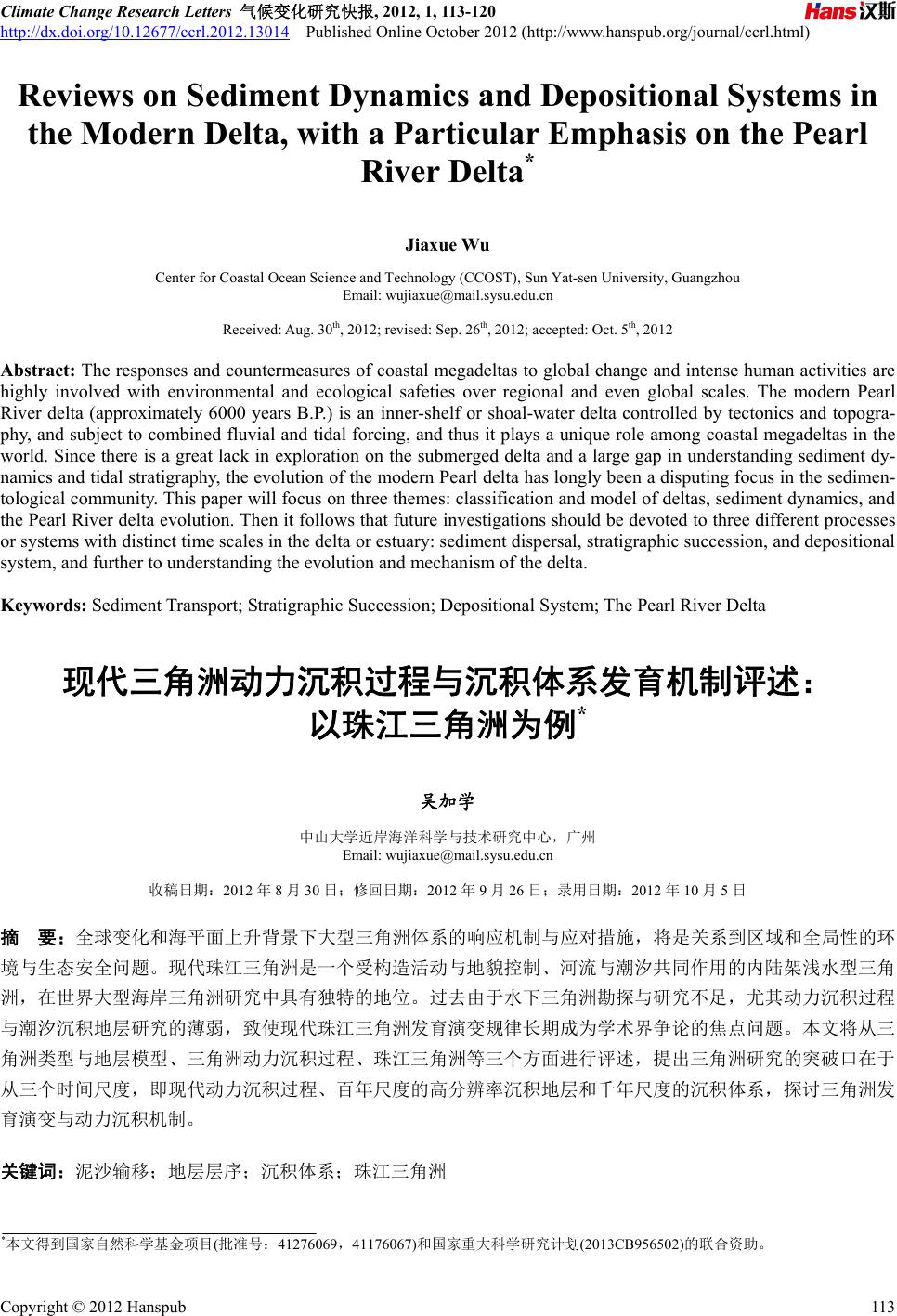 Climate Change Research Letters 气候变化研究快报, 2012, 1, 113-120 http://dx.doi.org/10.12677/ccrl.2012.13014 Published Online October 2012 (http://www.hanspub.org/journal/ccrl.html) Reviews on Sediment Dynamics and Depositional Systems in the Modern Delta, with a Particular Emphasis on the Pearl River Delta* Jiaxue W u Center for Coastal Ocean Science and Technology (CCOST), Sun Yat-sen University, Guangzhou Email: wujiaxue@mail.sysu.edu.cn Receiv ed: Aug . 30th, 2012; revised: Sep. 26th, 2012; accepted: Oct. 5th, 2012 Abstract: The responses and countermeasures of coastal megadeltas to global change and in tense human activities are highly involved with environmental and ecological safeties over regional and even global scales. The modern Pearl River delta (approximately 6000 years B.P.) is an inner-shelf or shoal-water delta controlled by tectonics and topogra- phy, and subject to combined fluvial and tidal forcing, and thus it plays a unique role among coastal megadeltas in the world. Since there is a great lack in exploration on the submerged delta and a large gap in understanding sediment dy- namics and tidal stratigraphy, the evolution of the modern Pearl delta has longly been a disputing focus in the sedimen- tological community. Th is paper will focus on three themes: classification and model of deltas, sediment dyna mics, and the Pearl River delta evolu tion. Then it follows that future investigations should be devoted to three different processes or systems with distinct time scales in the delta or estuary: sediment dispersal, stratigraphic succession, and depositional system, and further to understanding the evolution and mechanism of the delta. Keywords: Sediment Transport; Stratigraphic Succession; Depositional System; The Pearl River Delta 现代三角洲动力沉积过程与沉积体系发育机制评述: 以珠江三角洲为例* 吴加学 中山大学近岸海洋科学与技术研究中心,广州 Email: wujiaxue@mail.sysu.edu.cn 收稿日期:2012 年8月30 日;修回日期:2012 年9月26 日;录用日期:2012 年10 月5日 摘 要:全球变化和海平面上升背景下大型三角洲体系的响应机制与应对措施,将是关系到区域和全局性的环 境与生态安全问题。现代珠江三角洲是一个受构造活动与地貌控制、河流与潮汐共同作用的内陆架浅水型三角 洲,在世界大型海岸三角洲研究中具有独特的地位。过去由于水下三角洲勘探与研究不足,尤其动力沉积过程 与潮汐沉积地层研究的薄弱,致使现代珠江三角洲发育演变规律长期成为学术界争论的焦点问题。本文将从三 角洲类型与地层模型、三角洲动力沉积过程、珠江三角洲等三个方面进行评述,提出三角洲研究的突破口在于 从三个时间尺度,即现代动力沉积过程、百年尺度的高分辨率沉积地层和千年尺度的沉积体系,探讨三角洲发 育演变与动力沉积机制。 关键词:泥沙输移;地层层序;沉积体系;珠江三角洲 *本文得到国家自然科学基金项目(批准号:41276069,41176067)和国家重大科学研究计划(2013CB956502)的联合资助。 Copyright © 2012 Hanspub 113 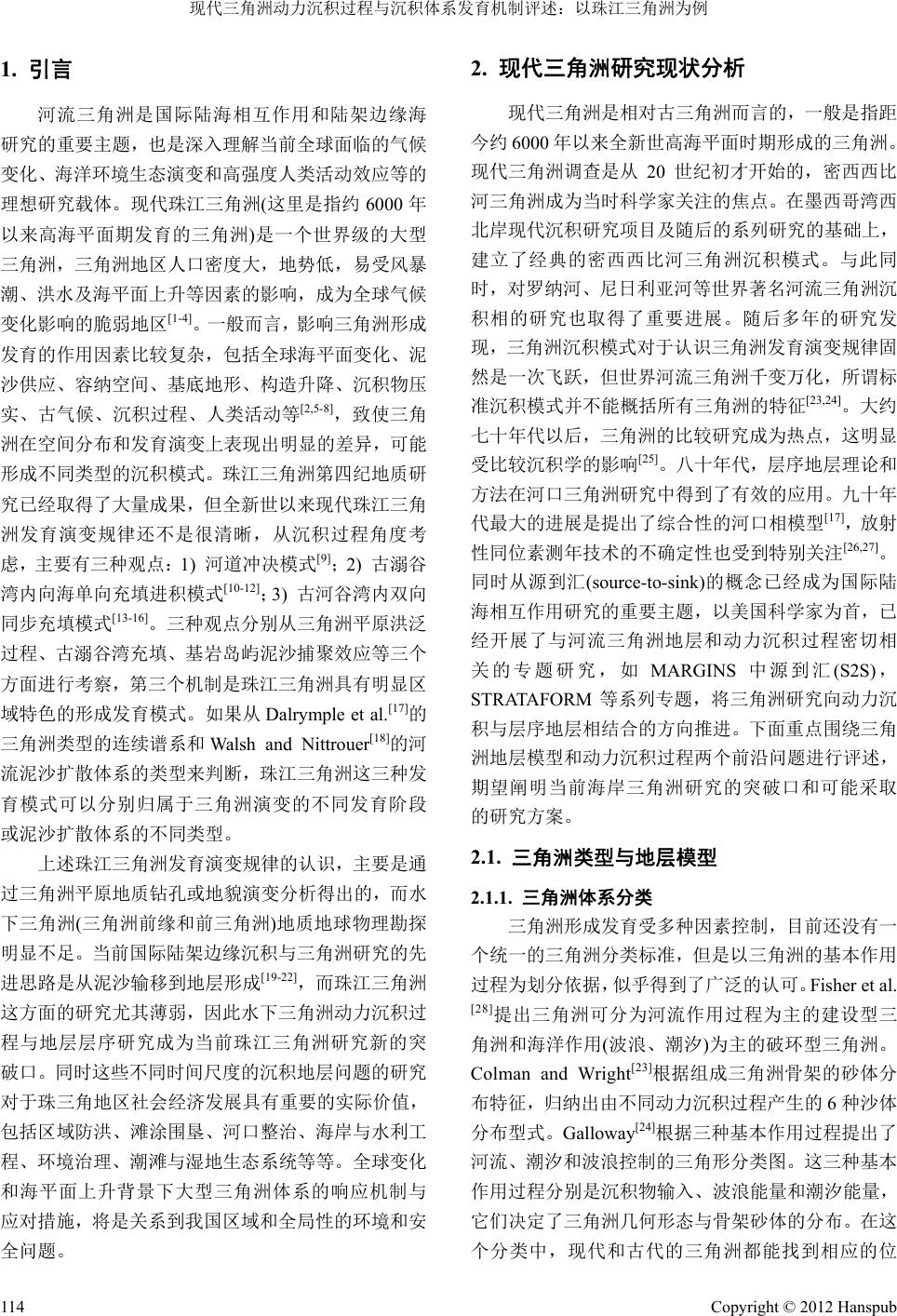 现代三角洲动力沉积过程与沉积体系发育机制评述:以珠江三角洲为例 1. 引言 河流三角洲是国际陆海相互作用和陆架边缘海 研究的重要主题,也是深入理解当前全球面临的气候 变化、海洋环境生态演变和高强度人类活动效应等的 理想研究载体。现代珠江三角洲(这里是指约 6000 年 以来高海平面期发育的三角洲)是一个世界级的大型 三角洲,三角洲地区人口密度大,地势低,易受风暴 潮、洪水及海平面上升等因素的影响,成为全球气候 变化影响的脆弱地区[1-4]。一般而言,影响三角洲形成 发育的作用因素比较复杂,包括全球海平面变化、泥 沙供应、容纳空间、基底地形、构造升降、沉积物压 实、古气候、沉积过程、人类活动等[2,5-8],致使三角 洲在空间分布和发育演变上表现出明显的差异,可能 形成不同类型的沉积模式。珠江三角洲第四纪地质研 究已经取得了大量成果,但全新世以来现代珠江三角 洲发育演变规律还不是很清晰,从沉积过程角度考 虑,主要有三种观点:1) 河道冲决模式[9];2) 古溺谷 湾内向海单向充填进积模式[10-12];3) 古河谷湾内双向 同步充填模式[13-16]。三种观点分别从三角洲平原洪泛 过程、古溺谷湾充填、基岩岛屿泥沙捕聚效应等三个 方面进行考察,第三个机制是珠江三角洲具有明显区 域特色的形成发育模式。如果从 Dalrymple et al.[17]的 三角洲类型的连续谱系和Walsh and Nittrouer[18]的河 流泥沙扩散体系的类型来判断,珠江三角洲这三种发 育模式可以分别归属于三角洲演变的不同发育阶段 或泥沙扩散体系的不同类型。 上述珠江三角洲发育演变规律的认识,主要是通 过三角洲平原地质钻孔或地貌演变分析得出的,而水 下三角洲(三角洲前缘和前三角洲)地质地球物理勘探 明显不足。当前国际陆架边缘沉积与三角洲研究的先 进思路是从泥沙输移到地层形成[19-22],而珠江三角洲 这方面的研究尤其薄弱,因此水下三角洲动力沉积过 程与地层层序研究成为当前珠江三角洲研究新的突 破口。同时这些不同时间尺度的沉积地层问题的研究 对于珠三角地区社会经济发展具有重要的实际价值, 包括区域防洪、滩涂围垦、河口整治、海岸与水利工 程、环境治理、潮滩与湿地生态系统等等。全球变化 和海平面上升背景下大型三角洲体系的响应机制与 应对措施,将是关系到我国区域和全局性的环境和安 全问题。 2. 现代三角洲研究现状分析 现代三角洲是相对古三角洲而言的,一般是指距 今约 6000 年以来全新世高海平面时期形成的三角洲。 现代三角洲调查是从20 世纪初才开始的,密西西比 河三角洲成为当时科学家关注的焦点。在墨西哥湾西 北岸现代沉积研究项目及随后的系列研究的基础上, 建立了经典的密西西比河三角洲沉积模式。与此同 时,对罗纳河、尼日利亚河等世界著名河流三角洲沉 积相的研究也取得了重要进展。随后多年的研究发 现,三角洲沉积模式对于认识三角洲发育演变规律固 然是一次飞跃,但世界河流三角洲千变万化,所谓标 准沉积模式并不能概括所有三角洲的特征[23,24]。大约 七十年代以后,三角洲的比较研究成为热点,这明显 受比较沉积学的影响[25]。八十年代,层序地层理论和 方法在河口三角洲研究中得到了有效的应用。九十年 代最大的进展是提出了综合性的河口相模型[17],放 射 性同位素测年技术的不确定性也受到特别关注[26,27]。 同时从源到汇(source-to-sink)的概念已经成为国际陆 海相互作用研究的重要主题,以美国科学家为首,已 经开展了与河流三角洲地层和动力沉积过程密切相 关的专题研究,如 MARGINS 中源到汇(S2S), STRATAFORM 等系列专题,将三角洲研究向动力沉 积与层序地层相结合的方向推进。下面重点围绕三角 洲地层模型和动力沉积过程两个前沿问题进行评述, 期望阐明当前海岸三角洲研究的突破口和可能采取 的研究方案。 2.1. 三角洲类型与地层模型 2.1.1. 三角洲体系分类 三角洲形成发育受多种因素控制,目前还没有一 个统一的三角洲分类标准,但是以三角洲的基本作用 过程为划分依据,似乎得到了广泛的认可。Fisher et al. [28]提出三角洲可分为河流作用过程为主的建设型三 角洲和海洋作用(波浪、潮汐)为主的破环型三角洲。 Colman and Wright[23]根据组成三角洲骨架的砂体分 布特征,归纳出由不同动力沉积过程产生的 6种沙体 分布型式。Galloway[24]根据三种基本作用过程提出了 河流、潮汐和波浪控制的三角形分类图。这三种基本 作用过程分别是沉积物输入、波浪能量和潮汐能量, 它们决定了三角洲几何形态与骨架砂体的分布。在这 个分类中,现代和古代的三角洲都能找到相应的位 Copyright © 2012 Hanspub 114  现代三角洲动力沉积过程与沉积体系发育机制评述:以珠江三角洲为例 置。Galloway and Xue[29]进一步考虑到沉积物粒径影 响,将两种粗碎屑三角洲(扇三角洲和辫状河三角洲) 引入 Galloway[24]正常三角洲分类三角图中,根据陆上 沉积过程和海洋改造性质,将三角洲体系细分成 9种 三角洲类型。同时他们也指出,现实的三角洲很少是 上述理想的端元类型,大多数为过渡类型。Dalrymple et al.[17,30]将海平面变化补充到 Galloway[24]的基本作 用过程中,建立了河口–三角洲发育类型的连续谱 系;同时从沉积相角度对河口三角洲动力沉积过程进 行了分区。Porebski and Steel[31]根据相对海平面变化 和泥沙扩散过程,提出了陆架三角洲发育的4种区位 类型,即湾头三角洲、内陆架或浅水三角洲、中陆架 三角洲和陆架边缘三角洲。最近 Walsh and Nittrouer[ 18] 根据现代入海河流泥沙扩散体系分布划分出 5种基本 类型,即河口湾沉积、近场沉积、海底峡谷聚集、海 洋扩散和水下三角洲斜坡沉积。 2.1.2. 层序地层模型与三角洲地层研究 标准的层序地层模型[32,33]是基于容纳空间与沉积 物供应之间不平衡形成的退积和进积过程,但绝大多 数的所谓通用模型并没有充分考虑作用过程的状态 变化与沉积相模式[34]。事实上,这些层序地层模型具 有很强的区域性,通常假设海岸带为波浪作用为主, 海侵期下切河谷的潮汐作用可以忽略[35,36]。然而现代 作用过程和第四纪沉积研究的证据充分表明波浪、潮 汐和河流输入的相对强度即使在千年尺度或更长的 周期上仍可能存在剧烈的变化[34],因此古沉积环境的 重建成为三角洲动力沉积过程和地层模拟研究的基 础。 应用地震地层学能系统地解释晚第四纪地层地 震反射剖面和接触关系,然而在高分辨率地层分析 中,已经证明直接应用“层序地层”的概念[37]是比较 困难的,即使海平面变化曲线已知的情况下亦如此。 相反地,动力地貌[38]、体系域[39]和沉积体系分析[40,41] 等概念的扩展(scale-up)将更加有助于高分辨率地层 分析与对比,而不是退宿(scale-down)到Posamentier and Vail[42]的第三级沉积层序或 Galloway[43]的成因层 序的概念上进行描述。 三角洲标准地层模型是一个以前积层为主的模 型[44,45],前积层发育厚度明显大于其上覆的顶积层和 下覆的底积层厚度,分流河道几乎没有体现在这些模 型中,表明分流河道最大深度等于顶积层厚度。三角 洲标准模型是依据经典的Gilbert 沉积相模式和密西 西比三角洲沉积模式的研究而提出来的,其中三角洲 的前积层是最明显的沉积地层体。然而,以前积层为 主的地层模型并不能解释所有三角洲地层结构,如以 顶积层为主的三角洲就是最明显的例子。Edmonds et al.[46]认为顶积层占优的三角洲与前积层占优的三角 洲在第一级地层结构上存在明显的差异,他们根据大 量现代三角洲几何特征的分析发现,现代三角洲是以 顶积层发育占优势,三角洲沉积环境包括分流河道、 天然堤、河口沙坝以及分流间湾[47],前积层坡度仅 2~4 度,分流河道可下切进入前积层。 如上所述,海洋作用控制的三角洲可以进一步分 为波浪和潮汐作用为主的两个端元类型,其中波浪作 用为主的三角洲远比潮汐作用为主的三角洲的研究 翔实,这是由于与潮汐河口沉积物充填有关的资料还 是非常有限的[48]。因此,尽管有大量的文献探讨下切 河谷的充填和潮汐环境的特征,但令人奇怪的是,潮 汐河口地层的研究却非常少,尤其在以下两个方面需 要加强[48]:1) 由于缺乏河口三角洲体系完整系统的资 料,泥沙充填的纵向变化仍然不是很清晰;2) 人类活 动对充填地层的影响不清楚[49]。 2.2. 三角洲动力沉积过程 早在上世纪三十年代,R. A. Bagnold从物理过程 来研究沉积作用,并用以解释层理构造的动力机制, 开创了动力沉积学研究的先河。沉积相与沉积体系概 念的提出,动力沉积学和层序地层学的发展,为三角 洲动力沉积学研究奠定了理论和方法基础。如果没有 这些统一的基本原理的支撑,三角洲研究就只能成为 上述“体系分类”或“标准模式”的探讨,三角洲形 成发育的动力过程与机制将不会搞清楚。 2.2.1. 三角洲地貌发育的作用因子 经典的观点认为三角洲地貌发育演变是由径流 量、潮差、波浪作用形成的[17,24]。后来研究进一步发 现,海平面上升[50-52]和人类活动[2,7]也是塑造三角洲地 貌变化的控制因子。对于泥沙类型与沉积物供应量的 效应则存在明显相反的两种观点,有些学者认为它们 是次要的[2,7,53],而另一些学者则发现它们也是控制因 子。对于泥沙粒径的影响,Galloway and Xue[29]将两 Copyright © 2012 Hanspub 11 5 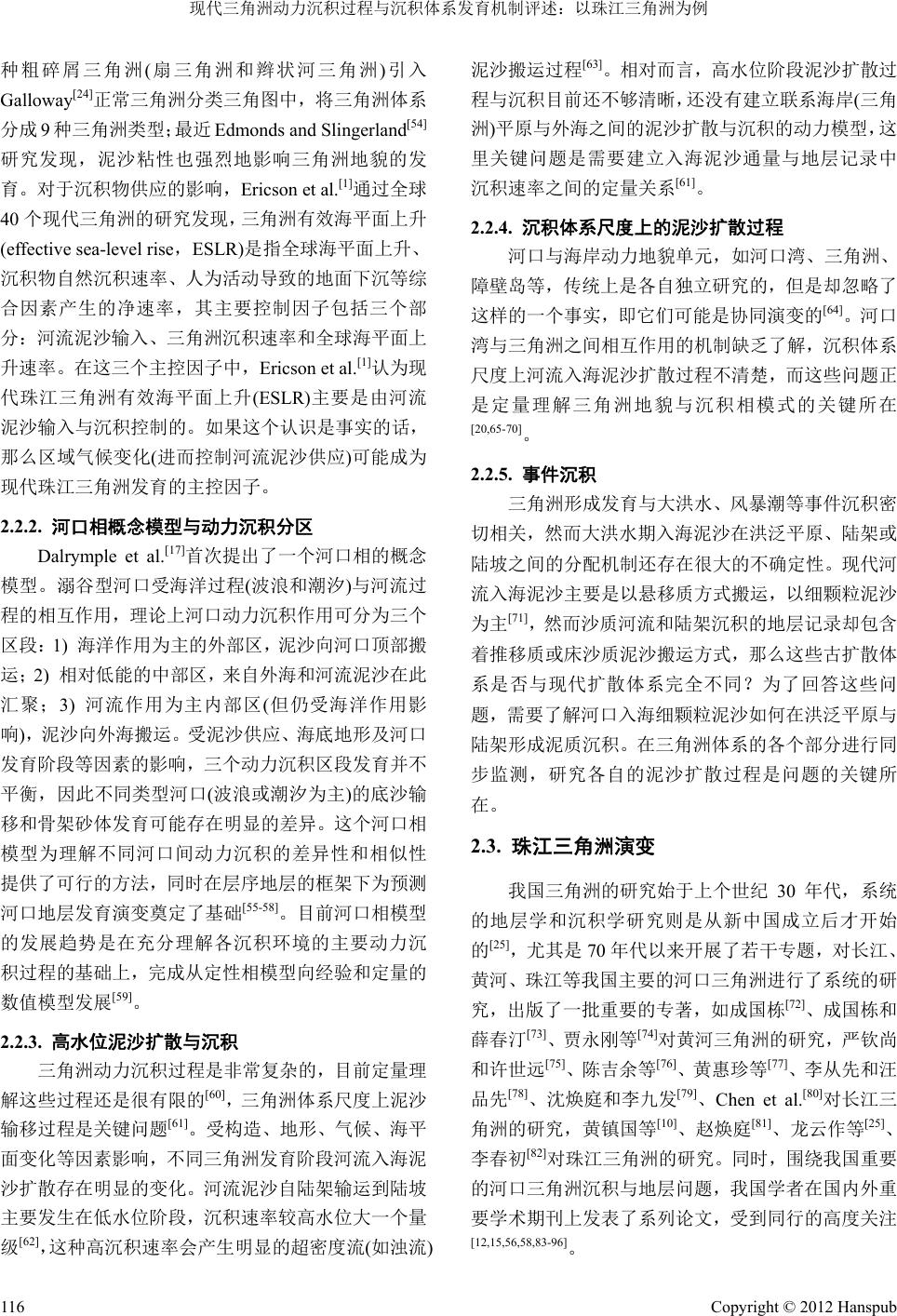 现代三角洲动力沉积过程与沉积体系发育机制评述:以珠江三角洲为例 种粗碎屑三角洲(扇三角洲和辫状河三角洲)引入 Galloway[24]正常三角洲分类三角图中,将三角洲体系 分成 9种三角洲类型;最近 Edmonds and Slingerland[54] 研究发现,泥沙粘性也强烈地影响三角洲地貌的发 育。对于沉积物供应的影响,Ericson et al.[1]通过全球 40 个现代三角洲的研究发现,三角洲有效海平面上升 (effective sea-level rise,ESLR)是指全球海平面上升、 沉积物自然沉积速率、人为活动导致的地面下沉等综 合因素产生的净速率,其主要控制因子包括三个部 分:河流泥沙输入、三角洲沉积速率和全球海平面上 升速率。在这三个主控因子中,Ericson et al.[1]认为现 代珠江三角洲有效海平面上升(ESLR)主要是由河流 泥沙输入与沉积控制的。如果这个认识是事实的话, 那么区域气候变化(进而控制河流泥沙供应)可能成为 现代珠江三角洲发育的主控因子。 2.2.2. 河口相概念模型与动力沉积分区 Dalrymple et al.[17]首次提出了一个河口相的概念 模型。溺谷型河口受海洋过程(波浪和潮汐)与河流过 程的相互作用,理论上河口动力沉积作用可分为三个 区段:1) 海洋作用为主的外部区,泥沙向河口顶部搬 运;2) 相对低能的中部区,来自外海和河流泥沙在此 汇聚;3) 河流作用为主内部区(但仍受海洋作用影 响),泥沙向外海搬运。受泥沙供应、海底地形及河口 发育阶段等因素的影响,三个动力沉积区段发育并不 平衡,因此不同类型河口(波浪或潮汐为主)的底沙输 移和骨架砂体发育可能存在明显的差异。这个河口相 模型为理解不同河口间动力沉积的差异性和相似性 提供了可行的方法,同时在层序地层的框架下为预测 河口地层发育演变奠定了基础[55-58]。目前河口相模型 的发展趋势是在充分理解各沉积环境的主要动力沉 积过程的基础上,完成从定性相模型向经验和定量的 数值模型发展[59]。 2.2.3. 高水位泥沙扩散与沉积 三角洲动力沉积过程是非常复杂的,目前定量理 解这些过程还是很有限的[60],三角洲体系尺度上泥沙 输移过程是关键问题[61]。受构造、地形、气候、海平 面变化等因素影响,不同三角洲发育阶段河流入海泥 沙扩散存在明显的变化。河流泥沙自陆架输运到陆坡 主要发生在低水位阶段,沉积速率较高水位大一个量 级[62],这种高沉积速率会产生明显的超密度流(如浊流) 泥沙搬运过程[63]。相对而言,高水位阶段泥沙扩散过 程与沉积目前还不够清晰,还没有建立联系海岸(三角 洲)平原与外海之间的泥沙扩散与沉积的动力模型,这 里关键问题是需要建立入海泥沙通量与地层记录中 沉积速率之间的定量关系[61]。 2.2.4. 沉积体系尺度上的泥沙扩散过程 河口与海岸动力地貌单元,如河口湾、三角洲、 障壁岛等,传统上是各自独立研究的,但是却忽略了 这样的一个事实,即它们可能是协同演变的[64]。河口 湾与三角洲之间相互作用的机制缺乏了解,沉积体系 尺度上河流入海泥沙扩散过程不清楚,而这些问题正 是定量理解三角洲地貌与沉积相模式的关键所在 [20,65-70]。 2.2.5. 事件沉积 三角洲形成发育与大洪水、风暴潮等事件沉积密 切相关,然而大洪水期入海泥沙在洪泛平原、陆架或 陆坡之间的分配机制还存在很大的不确定性。现代河 流入海泥沙主要是以悬移质方式搬运,以细颗粒泥沙 为主[71],然而沙质河流和陆架沉积的地层记录却包含 着推移质或床沙质泥沙搬运方式,那么这些古扩散体 系是否与现代扩散体系完全不同?为了回答这些问 题,需要了解河口入海细颗粒泥沙如何在洪泛平原与 陆架形成泥质沉积。在三角洲体系的各个部分进行同 步监测,研究各自的泥沙扩散过程是问题的关键所 在。 2.3. 珠江三角洲演变 我国三角洲的研究始于上个世纪30 年代,系统 的地层学和沉积学研究则是从新中国成立后才开始 的[25],尤其是 70 年代以来开展了若干专题,对长江、 黄河、珠江等我国主要的河口三角洲进行了系统的研 究,出版了一批重要的专著,如成国栋[72]、成国栋和 薛春汀[73]、贾永刚等[74]对黄河三角洲的研究,严钦尚 和许世远[75]、陈吉余等[76]、黄惠珍等[77]、李从先和汪 品先[78]、沈焕庭和李九发[79]、Chen et al.[80]对长江三 角洲的研究,黄镇国等[10]、赵焕庭[81]、龙云作等[25]、 李春初[82]对珠江三角洲的研究。同时,围绕我国重要 的河口三角洲沉积与地层问题,我国学者在国内外重 要学术期刊上发表了系列论文,受到同行的高度关注 [12,15,56,58,83-96]。 Copyright © 2012 Hanspub 116  现代三角洲动力沉积过程与沉积体系发育机制评述:以珠江三角洲为例 现代珠江三角洲的研究起步较早,自瑞典人柯维 廉(G. W. Olivecrona) 于1915年论述珠江三角洲的形成 至今近百余年来,珠江三角洲形成演化、三角洲沉积 相序、网河-河口湾沉积与地貌等问题一直成为学术 界关注的焦点问题,取得了许多重要的成果[9,10,12-15,81, 97-106]。珠江三角洲沉积地质与地貌问题已经开展了大 量研究,但是一些基本问题还是没有得到根本的解 决,比如珠江三角洲的形成发育机制仍然存在着很大 的分歧,归纳起来主要有四种观点:1) 断裂构造作用 形成的断块型三角洲[107,108];2) 海平面上升形成的湾 头充填沉积[109-113];3) 河道冲决形成的决口扇复合三 角洲[9,10];4) 溺谷湾“充填式”演进模式[13-15]。可以 看出,机制 1是三角洲形成的构造背景,机制 4是沉 积地貌发育过程;如果从层序地层的体系域角度划 分,则机制 2是海侵体系域,机制 3是高水位体系域。 值得注意的是,Ericson et al.[1]提出的控制三角洲有效 海平面上升的主要因子的研究,可以推测现代珠江三 角洲发育可能还与区域性气候长期变化有关。另外, 珠江流域人类活动对三角洲的影响近年来已经受到 学者们普遍的关注[114-118],如何清晰地描述这些影响 及作用机制还是一个相当困难的事情。 应该指出,在这些研究成果中珠江三角洲地形地 貌、构造地质等方面研究的较多,河口沉积(尤其动力 沉积)与层序地层的研究相对薄 弱; 陆地部 分(三角洲 平原)研究较详细,水下部分(三角洲前缘和前三角洲) 研究较薄弱;钻孔取样较多,但系统的测年数据明显 不足,海域勘探中与地球物理手段的结合用得较少。 近年来,Liu et al.[119],Zong et al.[12],Tang et al.[120]对 珠江水下三角洲或内陆架沉积地层进行了研究,但也 存在一些不足,如钻孔测年还不够系统,浅地震剖面 未能覆盖水下三角洲完整体系,钻孔与浅地震的结合 不够。从当前国际陆架边缘沉积研究的发展趋势来 看,从泥沙输移过程到层序地层是一条先进的研究思 路,而珠江三角洲在这方面的研究存在明显的不足, 尤其表现在沉积物供应的长期变化、三角洲尺度上入 海泥沙扩散体系、地层层序等问题的研究还非常薄 弱,甚至为空白,严重限制了对珠江三角洲形成发育 演变规律的认识。 3. 结论 本文基于当前国际陆架边缘海沉积和三角洲研 究的现状与发展趋势,分别从三角洲类型与地层模 型、三角洲动力沉积过程、珠江三角洲等三个方面进 行评述,提出三角洲研究的突破口在于从三个时间尺 度,即现代动力沉积过程、百年尺度的高分辨率沉积 地层和千年尺度的沉积体系,探讨三角洲发育演变与 动力沉积机制。研究技术上需采用先进的座底三脚架 系统对底边界层流与泥沙输移过程进行系统观测,运 用边界层与细颗粒泥沙动力学理论,揭示河口动力沉 积过程和入海泥沙扩散机制。同时采用钻孔和浅层地 震等地质地球物理方法,以高分辨率层序地层学为理 论基础,确定水下三角洲全新世以来的沉积地层结构 与特征,提取沉积环境信息,阐明三角洲发育演变规 律。 4. 致谢 中山大学地质系王建华教授对初稿提出了宝贵 意见。本文得到国家自然科学基金项目(批准 号: 41276069,41176067)和国家重 大科学研究计划(2013 CB956502)的联合资助。 参考文献 (References) [1] J. P. Ericson, C. J. Vorosmarty, S. L. Dingman, et al. Effective sea-level rise and deltas: Causes of change and human dimen- sion implications. Global Planet Change, 2006, 50: 63-82. [2] J. P. M. Syvitski, Kettner, et al. Sinking deltas due to human activities. Nature Geoscience, 2009, 2(10): 681-686. [3] I. Overeem, J. P. M. Syvitski. Dynamics and vulnerability of delta systems. LOICZ Reports & Studies No. 35. Geesthacht: GKSS Research Center, 2009. [4] R. J. Nicholls, A. Cazenave. Sea-level rise and its impact on coastal zones. Science, 2010, 328(5985): 1517-1520. [5] S. L. Goodbred Jr., Kuehl, et al. Controls on facies distribution and stratigraphic preservation in the Ganges-Brahmaputra delta sequence. Sedimentary Geology, 2003, 155: 301-316. [6] R. W. Dalrymple, K. Choi. Morphologic and facies trends th rough the fluvial-marine transition in tide-dominated depositional sys- tems: A schematic framework for environmental and sequence- stratigraphic interpretation. Earth-Science Reviews, 2007, 81(3-4): 135-174. [7] J. Syvitski, Y. Saito. Morphodynamics of deltas under the influ- ence of humans. Global and Planetary Change, 2007, 57: 261- 282. [8] J. P. M. Syvitski, Vorosmarty, et al. Impact of humans on the flux of terrestrial sediment to the global coastal ocean. Science, 2005, 308(5720): 376-380. [9] 曾昭璇, 黄少敏. 珠江三角洲历史地貌学研究[M]. 广州: 广 东高等教育出版社, 1987: 201. [10] 黄镇国, 李平日, 张仲英等. 珠江三角洲形成发育演变[M]. 广州: 科学普及出版社广州分社, 1982: 278. [11] 李平日, 乔彭年. 珠江三角洲六千年来的发展模式[J]. 泥沙 研究, 1982, 3: 33-42. [12] Y. Zong, G. Huang, A. D. Switzer, et al. An evolutionary model for the Holocene formation of the Pearl River delta, China. The Copyright © 2012 Hanspub 11 7 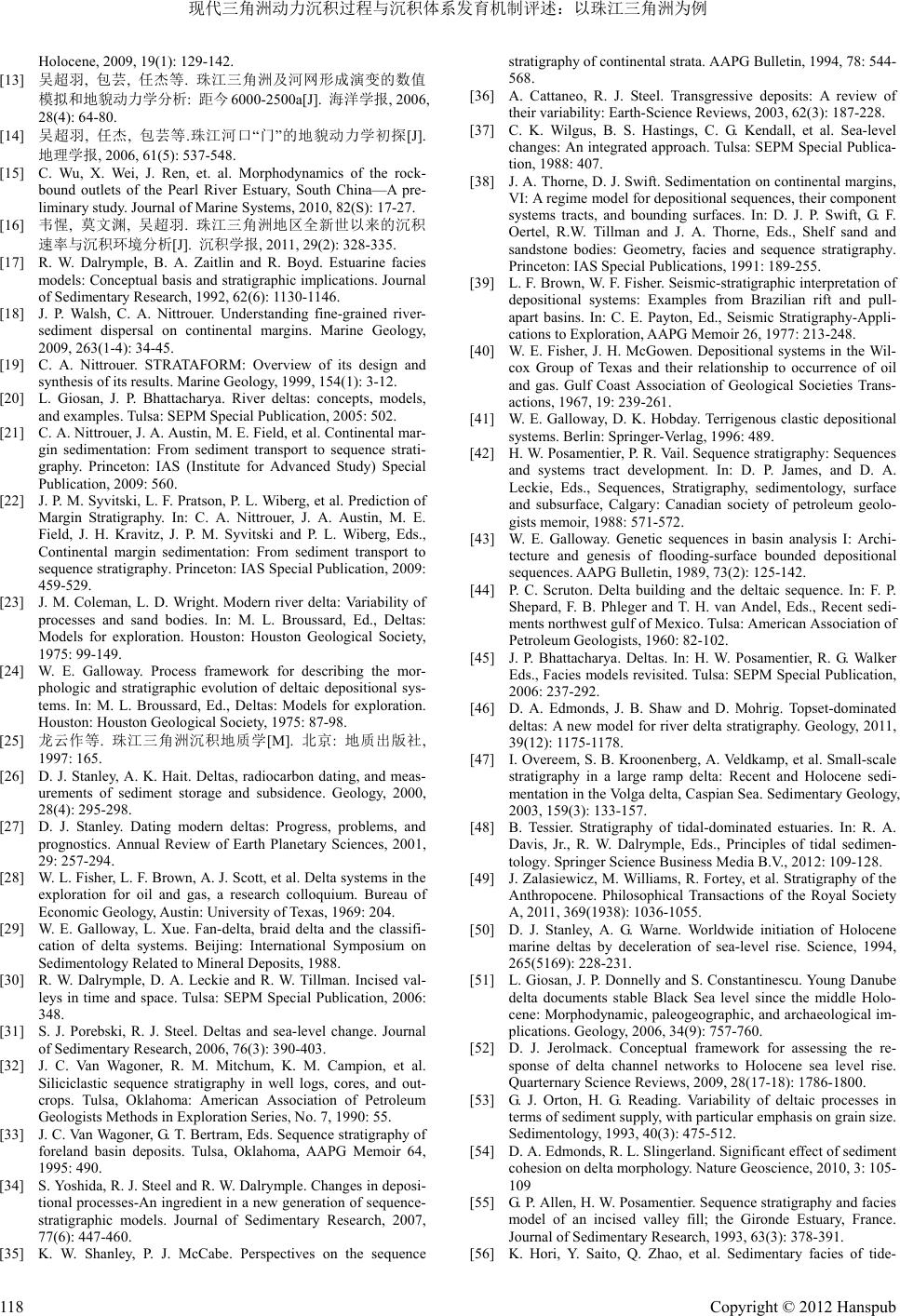 现代三角洲动力沉积过程与沉积体系发育机制评述:以珠江三角洲为例 Holocene, 2009, 19(1): 129-142. [13] 吴超羽, 包芸, 任杰等. 珠江三角洲及河网形成演变的数值 模拟和地貌动力学分析: 距今 6000-2500a[J]. 海洋学报, 2006, 28(4): 64-80. [14] 吴超羽, 任杰, 包芸等.珠江河口“门”的地貌动力学初探[J]. 地理学报, 2006, 61(5): 537-548. [15] C. Wu, X. Wei, J. Ren, et. al. Morphodynamics of the rock- bound outlets of the Pearl River Estuary, South China—A pre- liminary study. Journal of Marine Systems, 2010, 82(S): 17-27. [16] 韦惺, 莫文渊, 吴超羽. 珠江三角洲地区全新世以来的沉积 速率与沉积环境分析[J]. 沉积学报, 2011, 29(2): 328-335. [17] R. W. Dalrymple, B. A. Zaitlin and R. Boyd. Estuarine facies models: Conceptual basis and stratigraphic implications. Journal of Sedimentary Research, 1992, 62(6): 1130-1146. [18] J. P. Walsh, C. A. Nittrouer. Understanding fine-grained river- sediment dispersal on continental margins. Marine Geology, 2009, 263(1-4): 34-45. [19] C. A. Nittrouer. STRATAFORM: Overview of its design and synthesis of its results. Marine Geology, 1999, 154(1): 3-12. [20] L. Giosan, J. P. Bhattacharya. River deltas: concepts, models, and examples. Tulsa: SEPM Special Publication, 2005: 502. [21] C. A. Nittrouer, J. A. Austin, M. E. Field, et al. Continental mar- gin sedimentation: From sediment transport to sequence strati- graphy. Princeton: IAS (Institute for Advanced Study) Special Publication, 2009: 560. [22] J. P. M. Syvitski, L. F. Pratson, P. L. Wiberg, et al. Prediction of Margin Stratigraphy. In: C. A. Nittrouer, J. A. Austin, M. E. Field, J. H. Kravitz, J. P. M. Syvitski and P. L. Wiberg, Eds., Continental margin sedimentation: From sediment transport to sequence stratigraphy. Princeton: IAS Special Publication, 2009: 459-529. [23] J. M. Coleman, L. D. Wright. Modern river delta: Variability of processes and sand bodies. In: M. L. Broussard, Ed., Deltas: Models for exploration. Houston: Houston Geological Society, 1975: 99-149. [24] W. E. Galloway. Process framework for describing the mor- phologic and stratigraphic evolution of deltaic depositional sys- tems. In: M. L. Broussard, Ed., Deltas: Models for exploration. Houston: Houston Geological Society, 1975: 87-98. [25] 龙云作等. 珠江三角洲沉积地质学[M]. 北京: 地质出版社, 1997: 165. [26] D. J. Stanley, A. K. Hait. Deltas, radiocarbon dating, and meas- urements of sediment storage and subsidence. Geology, 2000, 28(4): 295-298. [27] D. J. Stanley. Dating modern deltas: Progress, problems, and prognostics. Annual Review of Earth Planetary Sciences, 2001, 29: 257-294. [28] W. L. Fisher, L. F. Brown, A. J. Scott, et al . Delta systems in th e exploration for oil and gas, a research colloquium. Bureau of Economic Geology, Austin: University of Texas, 1969: 204. [29] W. E. Galloway, L. Xue. Fan-delta, braid delta and the classifi- cation of delta systems. Beijing: International Symposium on Sedimentology Related to Mineral Deposits, 1988. [30] R. W. Dalrymple, D. A. Leckie and R. W. Tillman. Incised val- leys in time and space. Tulsa: SEPM Special Publication, 2006: 348. [31] S. J. Porebski, R. J. Steel. Deltas and sea-level change. Journal of Sedimentary Research, 2006, 76(3): 390-403. [32] J. C. Van Wagoner, R. M. Mitchum, K. M. Campion, et al. Siliciclastic sequence stratigraphy in well logs, cores, and out- crops. Tulsa, Oklahoma: American Association of Petroleum Geologists Methods in Exploration Series, No. 7, 1990: 55. [33] J. C. Van Wagoner, G. T. Bertram, Eds. Sequence stratigraphy of foreland basin deposits. Tulsa, Oklahoma, AAPG Memoir 64, 1995: 490. [34] S. Yoshida, R. J. Steel and R. W. Dalrymple. Changes in deposi- tional processes-An ingredient in a new generation of sequence- stratigraphic models. Journal of Sedimentary Research, 2007, 77(6): 447-460. [35] K. W. Shanley, P. J. McCabe. Perspectives on the sequence stratigraphy of continental strata. AAPG Bulletin, 1994, 78: 544- 568. [36] A. Cattaneo, R. J. Steel. Transgressive deposits: A review of their variability: Earth-Science Reviews, 2003, 62(3): 187-228. [37] C. K. Wilgus, B. S. Hastings, C. G. Kendall, et al. Sea-level changes: An integrated approach. Tulsa: SEPM Special Publica- tion, 1988: 407. [38] J. A. Thorne, D. J. Swift. Sedimentation on continental margins, VI: A regime model for depositional sequences, their component systems tracts, and bounding surfaces. In: D. J. P. Swift, G. F. Oertel, R.W. Tillman and J. A. Thorne, Eds., Shelf sand and sandstone bodies: Geometry, facies and sequence stratigraphy. Princeton: IAS Special Publications, 1991: 189-255. [39] L. F. Brown, W. F. Fisher. Seismic-stratigraphic interpretation of depositional systems: Examples from Brazilian rift and pull- apart basins. In: C. E. Payton, Ed., Seismic Stratigraphy-Appli- cations to Exploration, AAPG Memoir 26, 1977: 213-248. [40] W. E. Fisher, J. H. McGowen. Depositional syste ms in the Wil- cox Group of Texas and their relationship to occurrence of oil and gas. Gulf Coast Association of Geological Societies Trans- actions, 1967, 19: 239-261. [41] W. E. Galloway, D. K. Hobday. Terrigenous clastic depositional systems. Berlin: Springer-Verlag, 1996: 489. [42] H. W. Posamentier, P. R. Vail. Sequence stratigraphy: Sequences and systems tract development. In: D. P. James, and D. A. Leckie, Eds., Sequences, Stratigraphy, sedimentology, surface and subsurface, Calgary: Canadian society of petroleum geolo- gists memoir, 1988: 571-572. [43] W. E. Galloway. Genetic sequences in basin analysis I: Archi- tecture and genesis of flooding-surface bounded depositional sequences. AAPG Bulletin, 1989, 73(2): 125-142. [44] P. C. Scruton. Delta building and the deltaic sequence. In: F. P. Shepard, F. B. Phleger and T. H. van Andel, Eds., Recent sedi- ments northwest gulf of Mexico. Tulsa: American Association of Petroleum Geologists, 1960: 82-102. [45] J. P. Bhattacharya. Deltas. In: H. W. Posamentier, R. G. Walker Eds., Facies models revisited. Tulsa: SEPM Special Publication, 2006: 237-292. [46] D. A. Edmonds, J. B. Shaw and D. Mohrig. Topset-dominated deltas: A new model for river delta stratigraphy. Geology, 2011, 39(12): 1175-1178. [47] I. Overeem, S. B. Kroonenberg, A. Veldkamp, et al. Small-scale stratigraphy in a large ramp delta: Recent and Holocene sedi- mentation in the Volga delta, Caspian Sea. Sedimentary Geology, 2003, 159(3): 133-157. [48] B. Tessier. Stratigraphy of tidal-dominated estuaries. In: R. A. Davis, Jr., R. W. Dalrymple, Eds., Principles of tidal sedimen- tology. Springer Science Business Media B.V., 2012: 109-128. [49] J. Zalasiewicz, M. Williams, R. Fortey, et al. Stratigraphy of the Anthropocene. Philosophical Transactions of the Royal Society A, 2011, 369(1938): 1036-1055. [50] D. J. Stanley, A. G. Warne. Worldwide initiation of Holocene marine deltas by deceleration of sea-level rise. Science, 1994, 265(5169): 228-231. [51] L. Giosan, J. P. Donnelly and S. Constantinescu. Young Danube delta documents stable Black Sea level since the middle Holo- cene: Morphodynamic, paleogeographic, and archaeological im- plications. Geology, 2006, 34(9): 757-760. [52] D. J. Jerolmack. Conceptual framework for assessing the re- sponse of delta channel networks to Holocene sea level rise. Quarternary Science Reviews, 2009, 28(17-18): 1786-1800. [53] G. J. Orton, H. G. Reading. Variability of deltaic processes in terms of sediment supply, with particular emphasis on grain size. Sedimentology, 1993, 40(3): 475-512. [54] D. A. Edmonds, R. L. Slingerland. Significant effect of sediment cohesion on delta morphology. Nature Geoscience, 2010, 3: 105- 109 [55] G. P. Allen, H. W. Posamentier. Sequence stratigraphy and facies model of an incised valley fill; the Gironde Estuary, France. Journal of Sedimentary Research, 1993, 63(3): 378-391. [56] K. Hori, Y. Saito, Q. Zhao, et al. Sedimentary facies of tide- Copyright © 2012 Hanspub 118 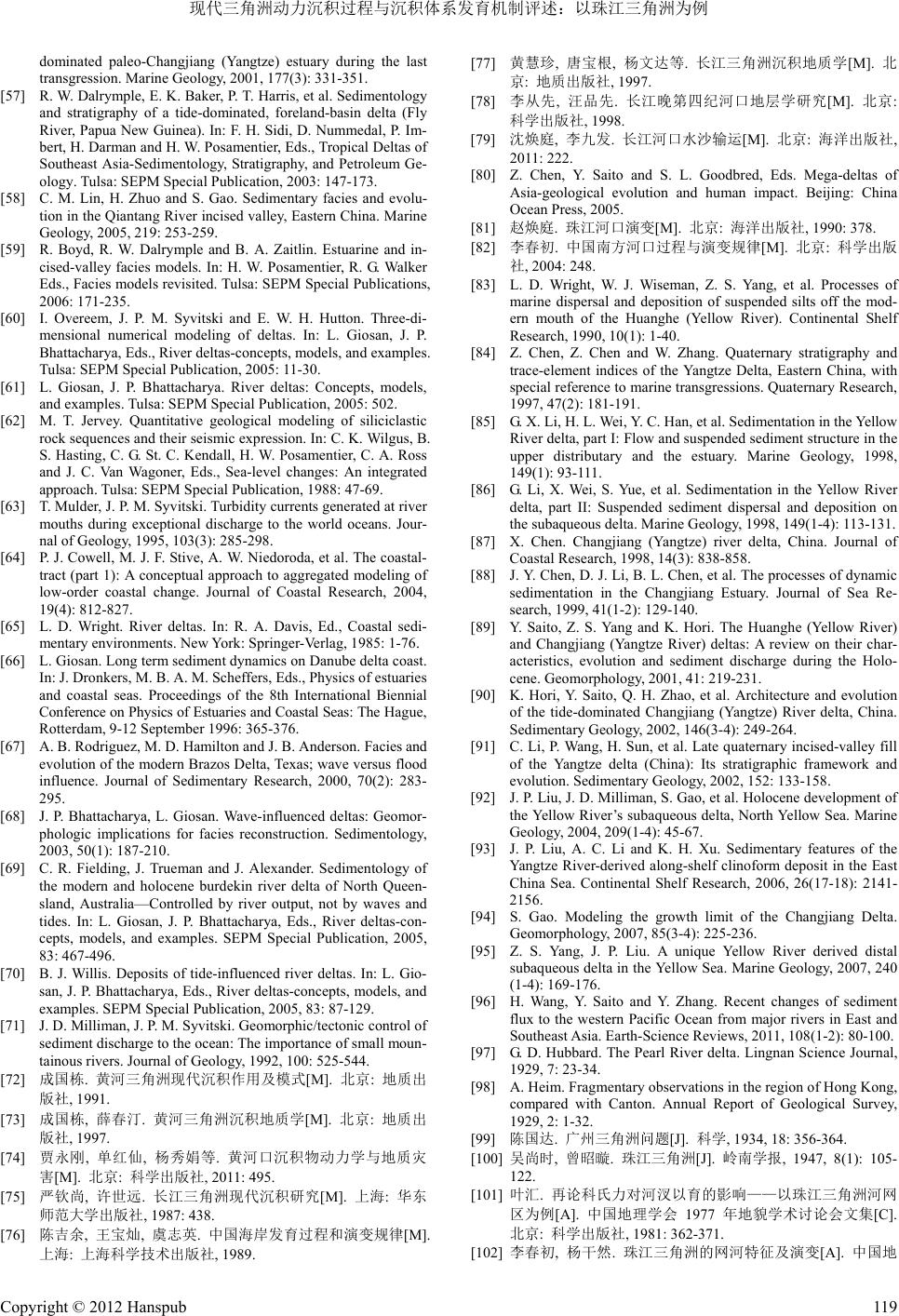 现代三角洲动力沉积过程与沉积体系发育机制评述:以珠江三角洲为例 dominated paleo-Changjiang (Yangtze) estuary during the last transgression. Marine Geology, 2001, 177(3): 331-351. [57] R. W. Dalrymple, E. K. Baker, P. T. Harris, et al. Sedimentology and stratigraphy of a tide-dominated, foreland-basin delta (Fly River, Papua New Guinea). In: F. H. Sidi, D. Nummeda l, P. Im- bert, H. Darman and H. W. Posamentier, Eds., Tropical Deltas of Southeast Asia-Sedimentology, Stratigraphy, and Petroleum Ge- ology. Tulsa: SEPM Special Publication, 2003: 147-173. [58] C. M. Lin, H. Zhuo and S. Gao. Sedimentary facies and evolu- tion in the Qiantang River incised valley, Eastern China. Marine Geology, 2005, 219: 253-259. [59] R. Boyd, R. W. Dalrymple and B. A. Zaitlin. Estuarine and in- cised-valley facies models. In: H. W. Posamentier, R. G. Walker Eds., Facies models revisited. Tulsa: SEPM Special Publications, 2006: 171-235. [60] I. Overeem, J. P. M. Syvitski and E. W. H. Hutton. Three-di- mensional numerical modeling of deltas. In: L. Giosan, J. P. Bhattacharya, Eds., River deltas-concepts, models, and examples. Tulsa: SEPM Special Publication, 2005: 11-30. [61] L. Giosan, J. P. Bhattacharya. River deltas: Concepts, models, and examples. Tulsa: SEPM Special Publication, 2005: 502. [62] M. T. Jervey. Quantitative geological modeling of siliciclastic rock sequences and their seismic expression. In: C. K. Wilgus, B. S. Hasting, C. G. St. C. Kendall, H. W. Posamentier, C. A. Ross and J. C. Van Wagoner, Eds., Sea-level changes: An integrated approach. Tulsa: SEPM Special Publication, 1988: 47-69. [63] T. Mulder, J. P. M. Syvitski. Turbidity currents generated at river mouths during exceptional discharge to the world oceans. Jour- nal of Geology, 1995, 103(3): 285-298. [64] P. J. Cowell, M. J. F. Stive, A. W. Niedoroda, et al. The coastal- tract (part 1): A conceptual approach to aggregated modeling of low-order coastal change. Journal of Coastal Research, 2004, 19(4): 812-827. [65] L. D. Wright. River deltas. In: R. A. Davis, Ed., Coastal sedi- mentary environments. New York: Springer-Verlag, 1985: 1-76. [66] L. Giosan. Long term sediment dynamics on Danube delta coast. In: J. Dronkers, M. B. A. M. Scheffers, Eds., Physics of estuaries and coastal seas. Proceedings of the 8th International Biennial Conference on Physics of Estuaries and Co astal Seas: Th e H ag u e , Rotterdam, 9-12 September 1996: 365-376. [67] A. B. Rodriguez, M. D. Hamilton and J. B. Anderson. Facies and evolution of the modern Brazos Delta, Texas; wave versus flood influence. Journal of Sedimentary Research, 2000, 70(2): 283- 295. [68] J. P. Bhattacharya, L. Giosan. Wave-influenced deltas: Geomor- phologic implications for facies reconstruction. Sedimentology, 2003, 50(1): 187-210. [69] C. R. Fielding, J. Trueman and J. Alexander. Sedimentology of the modern and holocene burdekin river delta of North Queen- sland, Australia—Controlled by river output, not by waves and tides. In: L. Giosan, J. P. Bhattacharya, Eds., River deltas-con- cepts, models, and examples. SEPM Special Publication, 2005, 83: 467-496. [70] B. J. Willis. Deposits of tide-influenced river deltas. In: L. Gio- san, J. P. Bhattacharya, Eds., River deltas-concepts, models, and examples. SEPM Special Publication, 2005, 83: 87-129. [71] J. D. Milliman, J. P. M. Syvitski. Geomorphic/tectonic control of sediment discharge to the ocean: The importance of small moun- tainous rivers. Journal of Geology, 1992, 100: 525-544. [72] 成国栋. 黄河三角洲现代沉积作用及模式[M]. 北京: 地质出 版社, 1991. [73] 成国栋, 薛春汀. 黄河三角洲沉积地质学[M]. 北京: 地质出 版社, 1997. [74] 贾永刚, 单红仙, 杨秀娟等. 黄河口沉积物动力学与地质灾 害[M]. 北京: 科学出版社, 2011: 495. [75] 严钦尚, 许世远. 长江三角洲现代沉积研究[M]. 上海: 华东 师范大学出版社, 1987: 438. [76] 陈吉余, 王宝灿, 虞志英. 中国海岸发育过程和演变规律[M]. 上海: 上海科学技术出版社, 1989. [77] 黄慧珍, 唐宝根, 杨文达等. 长江三角洲沉积地质学[M]. 北 京: 地质出版社, 1997. [78] 李从先, 汪品先. 长江晚第四纪河口地层学研究[M]. 北京: 科学出版社, 1998. [79] 沈焕庭, 李九发. 长江河口水沙输运[M]. 北京: 海洋出版社, 2011: 222. [80] Z. Chen, Y. Saito and S. L. Goodbred, Eds. Mega-deltas of Asia-geological evolution and human impact. Beijing: China Ocean Press, 2005. [81] 赵焕庭. 珠江河口演变[M]. 北京: 海洋出版社, 1990: 378. [82] 李春初. 中国南方河口过程与演变规律[M]. 北京: 科学出版 社, 2004: 248. [83] L. D. Wright, W. J. Wiseman, Z. S. Yang, et al. Processes of marine dispersal and deposition of suspended silts off the mod- ern mouth of the Huanghe (Yellow River). Continental Shelf Research, 1990, 10(1): 1-40. [84] Z. Chen, Z. Chen and W. Zhang. Quaternary stratigraphy and trace-element indices of the Yangtze Delta, Eastern China, with special reference to marine transgressions. Quaternary Research, 1997, 47(2): 181-191. [85] G. X. Li, H. L. Wei, Y. C. Han, et al. Sedimentation in the Yellow River delta, part I: Flow and suspended sediment structure in the upper distributary and the estuary. Marine Geology, 1998, 149(1): 93-111. [86] G. Li, X. Wei, S. Yue, et al. Sedimentation in the Yellow River delta, part II: Suspended sediment dispersal and deposition on the subaqueous delta. Marine Geology, 1998, 149(1-4): 113-131. [87] X. Chen. Changjiang (Yangtze) river delta, China. Journal of Coastal Research, 1998, 14(3): 838-858. [88] J. Y. Chen, D. J. Li, B. L. Chen, et al. The processes of dynamic sedimentation in the Changjiang Estuary. Journal of Sea Re- search, 1999, 41(1-2): 129-140. [89] Y. Saito, Z. S. Yang and K. Hori. The Huanghe (Yellow River) and Changjiang (Yangtze River) deltas: A review on their char- acteristics, evolution and sediment discharge during the Holo- cene. Geomorphology, 2001, 41: 219-231. [90] K. Hori, Y. Saito, Q. H. Zhao, et al. Architecture and evolution of the tide-dominated Changjiang (Yangtze) River delta, China. Sedimentary Geology, 2002, 146(3-4): 249-264. [91] C. Li, P. Wang, H. Sun, et al. Late quaternary incised-valley fill of the Yangtze delta (China): Its stratigraphic framework and evolution. Sedimentary Geology, 2002, 152: 133-158. [92] J. P. Liu, J. D. Milliman, S. Gao, et al. Holocene development of the Yellow River’s subaqueous delta, North Yellow Sea. Marine Geology, 2004, 209(1-4): 45-67. [93] J. P. Liu, A. C. Li and K. H. Xu. Sedimentary features of the Yangtze River-derived along-shelf clinoform deposit in the East China Sea. Continental Shelf Research, 2006, 26(17-18): 2141- 2156. [94] S. Gao. Modeling the growth limit of the Changjiang Delta. Geomorphology, 2007, 85(3-4): 225-236. [95] Z. S. Yang, J. P. Liu. A unique Yellow River derived distal subaqueous delta in the Yellow Sea. Marine Geology, 2007, 240 (1-4): 169-176. [96] H. Wang, Y. Saito and Y. Zhang. Recent changes of sediment flux to the western Pacific Ocean from major rivers in East and Southeast Asia. Earth-Science Reviews, 2011, 108(1-2): 80-100. [97] G. D. Hubbard. The Pearl River delta. Lingnan Science Journal, 1929, 7: 23-34. [98] A. Heim. Fragmentary observations in the region of Hong Kong, compared with Canton. Annual Report of Geological Survey, 1929, 2: 1-32. [99] 陈国达. 广州三角洲问题[J]. 科学, 1934, 18: 356-364. [100] 吴尚时, 曾昭暶. 珠江三角洲[J]. 岭南学报, 1947, 8(1): 105- 122. [101] 叶汇. 再论科氏力对河汊以育的影响——以珠江三角洲河网 区为例[A]. 中国地理学会 1977 年地貌学术讨论会文集[C]. 北京: 科学出版社, 1981: 362-371. [102] 李春初, 杨干然. 珠江三角洲的网河特征及演变[A]. 中国地 Copyright © 2012 Hanspub 11 9  现代三角洲动力沉积过程与沉积体系发育机制评述:以珠江三角洲为例 Copyright © 2012 Hanspub 120 理学会地貌专业委员会编, 中国地理学会一九七七年地貌学 术讨论会论文集[C]. 北京: 科学出版社, 1981: 67-75. [103] 李春初, 杨干然. 珠江三角洲河网特征及演变, 华南地理文 献选集[M]. 广州: 科学普及出版社广州分社, 1985. [104] 李平日, 乔彭年, 郑洪汉等. 珠江三角洲一万年来环境演变 [M]. 北京: 海洋出版社, 1991: 184. [105] 徐君亮, 李永兴, 蔡福祥等. 珠江口伶 仃洋 滩槽 发 育演 变[M]. 北京: 海洋出版社, 1985: 182. [106] 赵焕庭. 珠江河口演变[M]. 北京: 海洋出版社, 1990: 378. [107] 张虎南. 断块型三角洲[J]. 地理学报, 1980, 1: 58-67. [108] 黄玉昆, 夏法, 陈国能. 断裂构造对珠江三角洲形成和演化 的控制作用[J]. 海洋学报, 1983, 5(3): 316-327. [109] 赵焕庭. 珠江三角洲的形成和发展[J]. 海洋学报, 1982, 4(5): 595-607. [110] 龙云作, 霍春兰, 司桂贤等. 对珠江三角洲沉积特征和沉积 模式的一些认识[J]. 海洋地质与第四纪地质, 1985, 5(4): 49- 57. [111] 李春初, 杨干然. 珠江三角洲的形成、发育和演变[R]. 中山 大学地理系河口研究组, 1976. [112] 龙云作, 霍春兰, 司桂贤等. 对珠江三角洲沉积特征和沉积 模式的一些认识[J]. 海洋地质与第四纪地质, 1985, 5(4): 49- 57. [113] 龙云作, 霍春兰, 司桂贤等. 对珠江三角洲沉积特征和沉积 模式的一些认识[J]. 海洋地质与 第四纪地质, 1985, 5(4): 49-57. [114] 罗章仁, 罗宪林, 杨干然. 人类活动对珠江三角洲水道河床 演变的影响[J]. 热带地貌, 1999, 20(2): l-15. [115] 戴仕宝, 杨世伦, 蔡爱民. 51年来珠江流域输沙量的变化[J]. 地理学报, 2007, 62(5): 545-554. [116] S. B. Dai, S. L. Yang and A. M. Cai. Impacts of dams on the sediment flux of the Pearl River, southern China. Catena, 2008, 76(1): 36-43. [117] Y. Zong, F. Yu, G. Huang, et al. Sedimentary evidence of Late Holocene human activity in the Pearl River delta, China. Earth Surf. Process. Landforms, 2010, 35: 1095-1102. [118] J. Harff, T. Leipe and D. Zhou. Pearl River Estuary related sediments as response to Holocene climate change and anthro- pogenic impact. Journal of Marine Systems, 2010, 82: S1-S2. [119] J. P. Liu, Z. Xue, K. Ross, et al. Fate of sediments delivered to the sea by Asia large rivers: Long-distance transport and forma- tion of remote alongshore clinothems. The Sedimentary Record, 2009, 7(4): 4-9. [120] C. Tang, D. Zhou, R. Endler, et al. Sedimentary development of the Pearl River Estuary based on seismic stratigraphy. Journal of Marine System, 2010, 82(S): 3-16. |